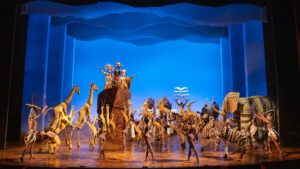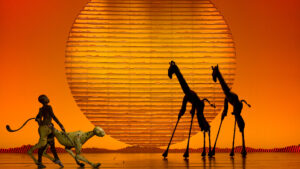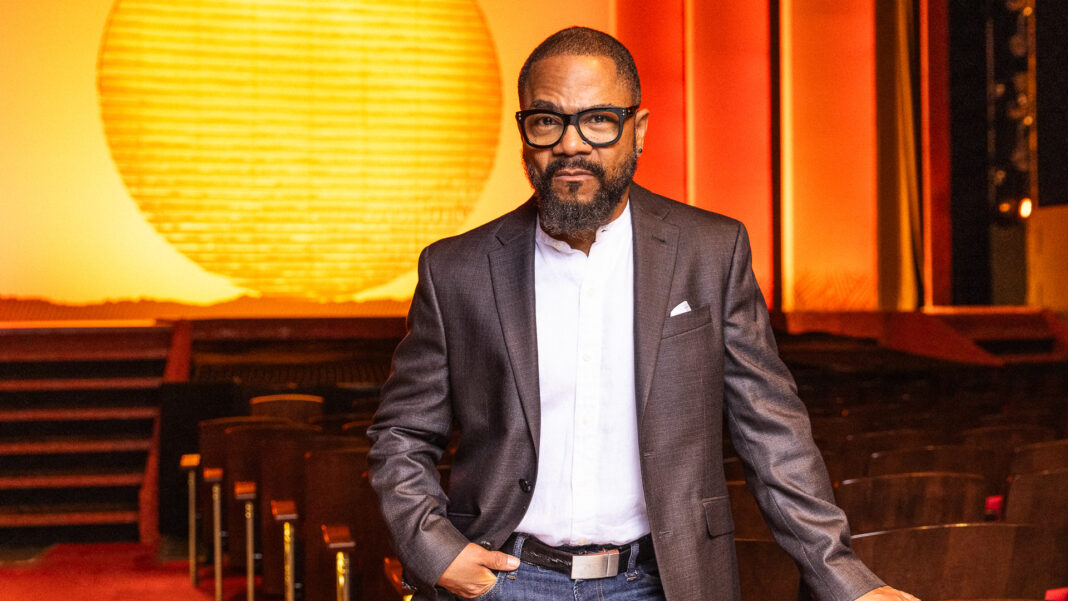
It didn’t take a rocket scientist to see that the Broadway musical The Lion King would be a monster hit when it opened in 1997. It was also clear that this is a tough show to perform. No one would know that better than Keith Bennett who is the Resident Director of the US Tour.
Bennett appeared on Broadway as Banzai, one of the hyenas in the show. The Lion King begins a 31-performance run at the Segerstrom Center for the Arts in Costa Mesa, CA on February 1st. The show then moves to Omaha, Nebraska; Minneapolis, MN; Dayton, OH and more. [You can find the full itinerary here.] Of course, the show continues on Broadway where The Lion King has amassed over 10,250 performances with no signs of stopping anytime soon.
Recently I spoke with Bennett about his work keeping this very precisely designed and choreographed show up to the highest possible standards. We also spoke about the role The Lion King has played in his life, but we started with a conversation about the first Broadway show in which Bennett appeared: Oh Kay! which opened at the Richard Rodgers Theatre on October 16, 1990 with a cast that included a future Tony Award winner.
What follows are excerpts from our conversation with Keith Bennett that have been edited for length and clarity. To see the full interview, please go to our YouTube channel.
Q: Before we start talking about The Lion King, I’m specifically thinking of a date October 16th, 1990. And on that date was the very first preview of Oh Kay! At the Richard Rodgers Theater when you were in a company that included Brian Mitchell, who did not go by Stokes at the time, in only his second show. At that point in your career, did you ever foresee into the future that your life and your career would be so entwined with one particular show?
Everything’s so spontaneous. You never know where you’re going to go. They used to call us gypsies. You go from one show to the next show to the next show. [Producer] David Merrick was behind the show, I thought it would run forever. When you’re young, you think that way. [Oh, Kay!, a revival of a Gershwin musical, ran for 77 performances.]
They used to have this event called Waiting in the Wings. They would get an understudy from each Broadway show and they would have a big night where you would perform and that night I did one of the numbers in the show. I understudied the great Stanley Wayne Mathis, who also took over the role of Bonzai on Broadway in [The Lion King]. I was this number called Fidgety Beat. So I went on that night, I did that number and I got an agent. So I wasn’t looking ahead at what’s going to be in the future.
As somebody who has been on stage in The Lion King, as Bonzai, how exacting is Julie Taymor’s direction? How much does that require of the cast members and how particular is Garth Fagan’s choreography so that every performance hums the way you probably remember it the first time you saw it?
The thing about them, it’s changed, too. I call it updating the product. It has evolved and keeps evolving. It keeps changing. A lot of it has gone back to the simplicity of telling the story. The same thing with the dance. The truth is when you look at Garth Fagan’s choreography, it’s not much you can change or alter. They mess around with the kick butt dance somewhat. The same thing with the direction. She comes in now and she updates certain things to make moments more clear.
Do you really have to make moments so clear when a show’s been running for 25 years? Isn’t there a certain clarity that the audience is already getting?
You want to keep it fresh. When a different performer comes in they have a different take on the role. We just had a lighting situation here in Portland. You maybe move something in a different area of the stage ever so slightly. The work itself, it’s changed somewhat. The truth is we changed some of the dialogue around ever so slightly. And the show has been cut down. We cut down the show for Vegas. And they saw that was a means of like, we can try this with the national tour.

In the first year or two of the show on Broadway, there were tons of stories about injuries. I’m assuming that technology has shifted and changed so that the costuming or the puppetry isn’t as heavy as it might have been when it first started. What does a performer go through, physically, during eight shows a week of The Lion King?
The Lion King is tough, number one. You’re dancing with ornaments and equipment on your head. There’s probably not one character in the show that gets a break. Everyone wears something that can be constricting in terms of movement. You find you’re in constant mode of exercise and taking ballet classes because it’s tough.
It also is not just a costume. I call it equipment that we wear. Eight shows a week is hard on all those dancers. On Broadway they have a raked stage. So my heart goes out to all those dancers. You have to stay in the gym. You have to train. You have to get your rest. But the honest truth is sometimes that’s not enough. We’ve had a lot of injuries. That’s why we have a lot of people coming in and out and people who have to take time off to let the body heal. It’s a hard show. But that’s what the public likes, seeing the costumes and how big they are.
As resident director, Keith Bennett, you have to make sure the show is consistently good night after night after night. How difficult is it to maintain that level of consistency night after night, week after week, town after town?
I’m blessed to have these trained actors that know where to go on stage at what point, and the script. It’s been easy for me. It’s been easy to maintain. There haven’t been too many issues. Of course, when, I call them the big wigs, come out here, they update and change some things around based on Julie’s vision. But other than that, I’ve been blessed to have these guys stick to the script.
I’m not the type of director, you know, paint by numbers. When I work with them, I believe if you want to get the best out of your actor, it has to be a collaboration, a coming together. A meeting of the minds when you sit down and you’re working on a certain scene and you tell them, all right, let’s sculpt this. Let’s take this thing and sculpt it and see what happens.
I read an interview that Julie Taymor gave the New York Times in 1997, around the time of the show’s opening on Broadway, and she was talking about the puppetry in particular. She said, “I want to see the rough edges. I don’t want it to be slick.” Doesn’t a long-running show, and a show that’s toured the world as many times as The Lion King has, have to be slick to be as successful as it is?
You have to work against that, because that work machine can stifle the creativity. One has to work against that. I think that’s why she comes back, to keep it fresh and maybe change some things around. Here’s the truth though. Most of these actors have their own interpretation. Which takes away from it being just a mechanical machine performance. They have their own way. It’s still defined, but, you have the human element behind it, which takes away from that thing of being just slick.
I think the long running successes of a show like The Lion King or Phantom of the Opera or Chicago, is that kind of success good for Broadway? Doesn’t that at a certain level rule out any number of shows that could equally be as worthy as those or any other show that’s on Broadway from getting a chance to be seen?
Put it this way for the actor it has its financial benefits.
And for the creators.

And for the creators, but we know the creators are going to be fine. The thing I like about a long-running show like this, you have dancers who now can establish a financial foundation. We’re in this business. We love doing good work, but we do want to eat at the same time.
I was in a show called High Rollers. We were at the Helen Hayes Theater. We closed in three weeks. We have to be honest. That’s the nature of the business. I guess that’s why when I got The Lion King, I was like, I’m going to milk this cow for as long as I can. In the 80s and the 90s, I paid my dues. That’s the only thing I can say. I do love new works coming to Broadway. There’ve been some incredible shows that only lasted for a year.
Or lasted much less than that. The hottest ticket in New York right now is the first-ever revival of Stephen Sondheim’s Merrily We Roll Along, and the original production in 1981 only ran 16 performances.
And that’s just how it is. I went to a party some years ago.People were like, you get a good government check. That’s what they were saying about The Lion King. They know that show was not going anywhere. I’ve been able to put myself in a different financial situation with my family. I talk to a lot of people they’re like, God, that show has been running a long time. They want to do something different. But for me, the financial benefits outweigh me going for a job. I do hope a lot of shows get more longevity.
Keith Bennett, you played Richie in A Chorus Line. As you well know, when Paul injures himself late in the show, the question comes up, what do you do when you can’t dance anymore? Clearly, you’ve found an answer for yourself by being involved as long as you have been with The Lion King. But what do you think you’ll do when you can no longer feel the love tonight? When you can no longer wake up in the morning and say I can’t wait to be on this show?
You move on to something else that’s gonna inspire you. You have to do more than one thing. I’ve been able to study acting, singing and dancing. When I left the show on Broadway, my wife and I went back out to LA, and then we moved down to Florida. I got my real estate license.
When you feel that thing is draining from you, that’s when you have to make the decision. Either you try to regroup to find something else that can further involve you in this thing, or you have to say to yourself, I have to move on. The thing with this show directing thing, though, it’s so much to learn. But when that time comes, I just have to make that decision. Trust in God and say, okay, Keith, it’s time for you to go and do something. I’ve done it hundreds of times in my career. What do you do when the show closes? You go and audition for another show.
To see the full interview with Keith Bennett, please go here.
Main Photo: Resident Director Keith Bennett (Photo by Matthew Murphy)










